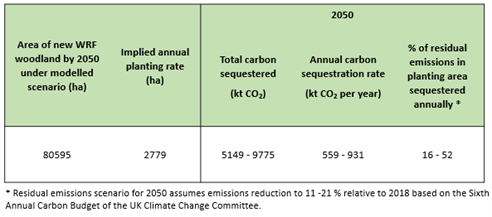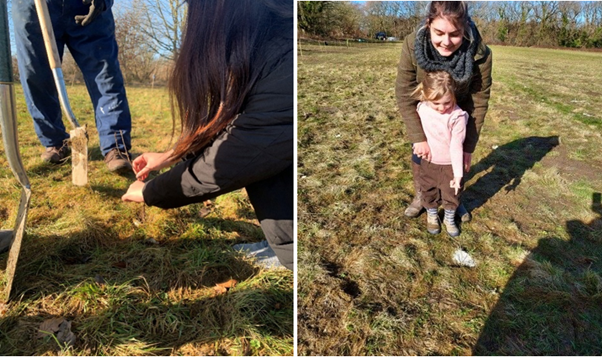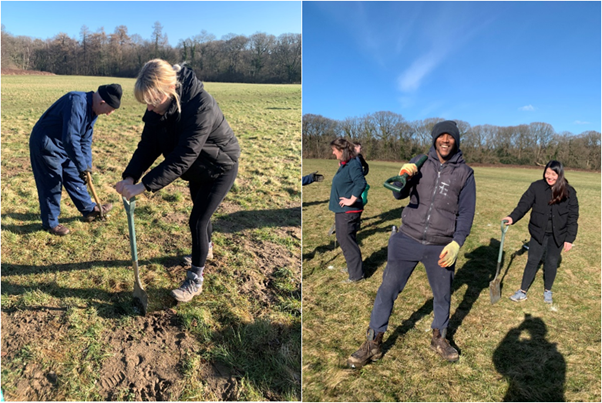To mark Belzona’s 70th anniversary, volunteers from our European Headquarters in Harrogate got together, along with family members, to plant over 1,000 trees in the Royal Forest of Knaresborough. This was the first of many environmental activities that the Belzona Team will be taking part in as part of an ambitious three-year partnership with the White Rose Forest, the community forest for North and West Yorkshire.

White Rose Forest Aim to Plant Seven Million Trees in North and West Yorkshire
Belzona is committed to investing in business practices and initiatives that support a more environmentally sustainable future. As such, Belzona’s Environmental Committee identified a fantastic opportunity to support the White Rose Forest in their plans to plant seven million trees across North and West Yorkshire by 2025.
In their Action Plan 2021 – 2025, the community forest outlines how: “Seven million trees, the equivalent of 4,900 football pitches or 3,500 hectares, could be planted in North and West Yorkshire between 2021 and 2025.”
The Action Plan goes on to explain the positive environmental impact this would have in terms of carbon sequestration. It says: “We estimate, for example, that if we were to increase tree cover in North and West Yorkshire from 11% to 19% by 2050, we could annually sequester up to 50% of potential residual CO2 emissions* from 2050.”
*These residual CO2 emissions relate to the estimated amount of CO2 that will remain in our atmosphere assuming that emissions pathway reductions are followed in North and West Yorkshire.
New Woodland Creation Integral to UK Government’s Net Zero Strategy
Explaining this process of carbon sequestration further, in a presentation held at Belzona’s 70th Anniversary celebrations, Dr Thomas Sloan, Forest Science and Policy Fellow at the United Bank of Carbon (UBoC) said: “Planting trees is a very good way to remove carbon from the atmosphere. New woodland creation is going to form part of our strategy to get to net zero. The UK Government is committed to reaching net-zero by 2050, and within the White Rose Forest region, some of the local authorities are planning to meet net-zero emissions before that, so in the late 2030s.”
Dr Sloan went on to discuss how carbon sequestration is a necessity, and how the best way to achieve it, is through tree planting.
He said: “There are two components to reaching net-zero. Firstly, reduce the emissions we create by decarbonising the economy. There are a variety of estimates as to how this is going to work, but broadly speaking within the next few decades, you have to remove 80 – 90% of emissions you actually create. This is going to leave 10 – 20% of emissions that you can’t really avoid making. So those are the emissions you have to take out of the atmosphere, usually by changing the way you use land and the best way to do that is by planting trees.”
He added: “The 80,595 hectares of forest that the White Rose Forest is intending to plant could be removing up to 52%, so up to half of the remaining carbon that’s produced within the region. This could make a huge contribution to reaching net zero.”

Further Environmental, Economic and Community Benefits
Not only do trees make a significant and essential contribution to removing residual carbon dioxide from the Earth’s atmosphere, according to the Action Plan 2021 – 2025, they also bring a whole host of other benefits to the economy, the environment and the community. These include:
Flood Risk Mitigation
Carefully targeted woodland creation in rural river catchments will, over time, help reduce flooding in towns and cities downstream.
Air Cooling
Trees help clean and cool the air in urban areas, offsetting the stifling effects of both pollution and climate change, and creating more pleasant places to live and work.
Economic Investment
A well-designed and maintained urban forest will boost investor confidence in our region and help us retain our people and businesses by providing attractive working environments.
Public Wellbeing
By improving the quality of public open spaces, trees encourage us to be more active outside, which has positive outcomes for both our mental and physical health.
Sustained Biodiversity
Trees provide and protect natural habitats and connect species migration corridors, creating greater areas of biodiversity, as recommended by the Lawton Review.

Belzona’s Three-Year Partnership the White Rose Forest
As part of Belzona’s partnership with the White Rose Forest, over the course of three years, employees will be taking part in a series of fundraising and tree planting activities. This will help to support the community forest and the critical work they are doing to help local councils achieve net zero by 2050, if not before.
The Belzona staff responsible for organising the partnership include Corporate Development Supervisor, Natalie Carpenter and Corporate Development Assistant, Lily Alexander-Pike. In a joint statement, they said: “We were absolutely thrilled to see so many colleagues getting involved in our first tree planting project. Working alongside the Bilton Conservation Society, 25 Belzona volunteers, including employees and family members, worked together to plant 1,200 trees in the local area. This is an incredible achievement – thank you to everyone who got involved! What a way to kick off our three-year partnership with the White Rose Forest!”

Click here to learn more about the White Rose Forest.

Chloe Hirst is the Senior Copywriter at Belzona Limited and is based in Harrogate, England. She gained a Bachelor’s Degree (with Hons.) in Media and Communications (specialising in Journalism) at Goldsmiths College, University of London. Chloe regularly writes case studies and thought leadership content featuring a variety of different industries, with a special focus on the renewables sector. In both 2023 and 2024, she won the Best Manufacturing Content Creation Specialist (UK) Award as part of Acquisition International’s Influential Businesswoman Awards.



